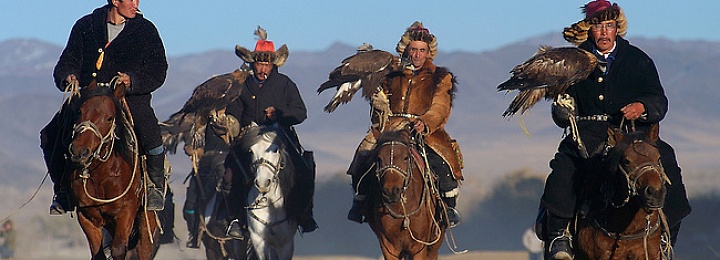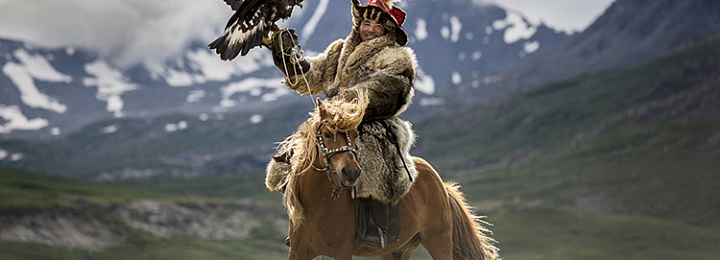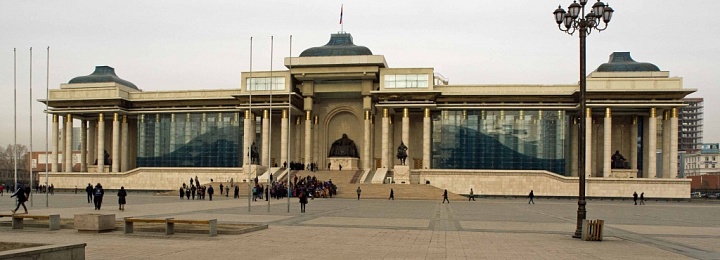Hotels
About Kazakhstan
Contacts
UZBEKISTAN
45/405 Shota Rustaveli Street
100100
Tashkent, Uzbekistan
PAKISTAN
Mezzanine Floor., Office 8A
Mushtaq Mansion, Block D
Fazel-e-Haq Road, Blue Area
Islamabad, Pakistan
E-mail: tashkent@sitara.com islamabad@sitara.com
Phone (Uzbekistan): (99871) 2814148, (99871) 2814149, (99871) 2553504
Phone (Pakistan): (9251) 2805583, (9251) 2805288
Fax: (99871) 1206500
Send request
Golden Eagle Hunters of Mongolia
-
Itinerary:Ulaanbaatar - Middle Gobi desert - Erdene Ukhaa - Tsagaan Suvarga - Bayanzag - Gobi Naran camp - Horyn Gol - Sand dunes - Bayanzag - Gobi Naran Camp - Dalanzagad - Ulaanbaatar - Ulgii - Ulaanbaatar
-
Duration:12 days / 11 nights
-
Price:on request
-
Tour program
Itinerary of «Golden Eagle Hunters of Mongolia»Day 01: Arrive Ulaanbaatar – Flt
Meeting on arrival assistance and transfer to hotel.
Lunch at local restaurant
We shall start our sightseeing tour of Ulaanbaatar with a visit to Ghengiz Khan Square, Gandan Monastery, Statue of Migjid Janraiseg, Zaidan memorial and the National Museum of Mongolia
Dinner and overnight at hotel
Day 02: Ulaanbaatar/Middle Gobi desert/Erdene Ukhaa – 360 kms – 5/6 hrs
Morning depart by four wheel drive to the mid of Gobi desert on the way shall visit Baga
Gazryn Chuluu and Sumhuh Burd – we shall see an ancient royal castle remains Picnic Lunch enroute
On arrival transfer to Ukhaa Ger camp
Dinner and overnight at the camp
Day 03: Erdene/Tsagaan Suvarga – 170 kms – 4 hrs
Morning depart for more adventure in the Gobi desert as we move deeper inside. We may come across the Shepherd and Mongols who repose during the season in the desert now start returning to the town ships
On arrival camp at regular Tourist Ger camp
Meals and overnight
Day 04: Bayanzag/Gobi Naran camp – 280 kms – 6 hrs
We continue off the beaten tracks deeper into Gobi desert with unique scenery of the steppes and occasionally meeting the nomadic people in the desert or chat with a family in the desert. On arrival transfer to Naran Camp
Meals and overnight
Day 05: Gobi Naran/Horyn Gol and Sand dunes – 250 kms – 5 hrs
We shall drive into Horyn Gol Oasis – we shall explore the beautiful surroundings with Seerun Bulag(Spring) at the foot of Singing Dunes. We shall then visit the local camel breeder’s Family – we can have camel ride for a short
Meals and overnight
Day 06: Horyn Gol/Bayanzag/Gobi Naran Camp – 200 kms – 4 hrs
We shall drive back to Bayanzag – Gobi Naran Camp – explore the flaming cliffs (geophysical formations due wind erosion) then explore the “Cemetery of Dinosaurs” this is the trail of Roy Chapman Andrews – the American explorer and naturalist who drove deeper into Gobi desert in 1920 and discovered the egg shells of dinosaurs and later drove an expedition in 1922 with a fleet of dodges. He kept visiting the desert searching for more fossil remains of the animals that once ruled part of Mongolian deserts
Meals and overnight at the camp
Day 07: Gobi Naran/Dalanzagad – 235 kms – 4 hrs
Dalanzagad/Ulaanbaatar – Flt
morning we shall drive to Dalanzagad town and catch the flight for Ulaan Bataar
on arrival transfer to hotel.
Free at leisure
Meals and overnight
Day 08: Ulaanbaatar/Ulgii – Flt
We shall fly in the morning to Ulgii – the western most province of Mongolia. Ulgii is inhabited by Kazakh nationality who continue their customs according to their nomadic culture spread over several centuries. They are animal herders raising cattle and horses in whole western region.
On arrival transfer to Eagle’s Nest Hotel
Meals and overnight
Day 09: Ulgii
We shall take part in the Golden Eagle Festival – performed near the mountain side of Ulgii Aimag. The highlight festivities are parade, cultural exhibitions and horse racing, This is followed by Golden Eagle Hunters who parade with their birds of pride. There is a mockup hunt for the young ones who astride horse release their bird of pray on a stuffed animal being pulled by a horse
we shall see the exhibition and smaller competitions – later at the end of the day return to our hotel.
Meals and overnight
Day 10: Ulgii
Today is the main day when birds are released from mountain side on the live animals running below – fastest attacking bird wins the competition
the day will end with prize distribution ceremony with pomp and show
later after taking part in the day long festivity we shall return to our hotel.
Meals and overnight
Day 11: Ulgii/Ulaan Bataar – Flt
We shall board a morning plane for flight back to Ulaanbaatar – on arrival transfer to hotel.
Free time for shopping
Meals and overnight
Day 12: Ulaanbaatar/Departure – Flt
Morning transfer to airport for your destination flight
Assistance on departure
-
Details
Details of itinerary & mapNomadism was largely practiced and even today 30% of Mongols are nomadic roaming in the steppes carrying huge herds of sheep, cows, horses and yaks could be a common scene of the countryside outside Ulaanbaatar, the capital city of Mongolia. Mongols predominantly practice Buddhism with small numbers practicing Shamnism and Islam.
Today Mongols are discovering their identity and introduction to the world through sports and festivals, like the annual summer festival of Nadam is well known and various forms related to ancient Mongol sports like horse riding, arrow shooting, wrestling and other minor nomadic sports.
The western part of Mongolia is largely inhabited by Kazakh ethnic group which is closely related to neighboring Kazakhstan are pastoral tribes with large animal herds. Kazakhs are mainly inhabiting the mountainous zones and are known Eagle Hunters. Eagle Hunting was known in the region since Khitan nomadic people in 10th AD who had trained hunters. Later being very closely affiliated with these nomadic people the sport was more popular among the Kazakh and Kyrgyz people. Mongol Kazakhs who migrated into present day western parts of Mongol Altai during the Soviet rule due harsh roping in of nomadic culture. Now these Kazakh tribes form an important ethnic group of Mongolia described as rich herders. During the winter months when these tribes are more at leisure they adopt their ancestral sport of Eagle Hunting. They form small groups of horsemen driving foxes and hares which provides them exotic meat and fur for their cold winters. An Eagle Hunter is called ‘Kus-beki’ (Kus – bird & beki – caretaker) is an old term used for Khan’s courtier more commonly called ‘Khushbeki’ the chief advisor. Since on hunting tours ‘Khush-beki’ had an important position in Khan’s entourage thereby confirming him of great trust of Khan’s court.
Kazakhs of Mongolia celebrate ‘Eagle Festival’ in the first weeks of October before the approach of severe winter months. These are groups of competing Eagle Hunters who do mock up and real eagle hunting performed in Ulgii, the main city of Bayan Ulgii -
Prices
Tour cost in USDPrice available on request.
-
Reviews
-
Book this tour
Booking form for "Golden Eagle Hunters of Mongolia"











